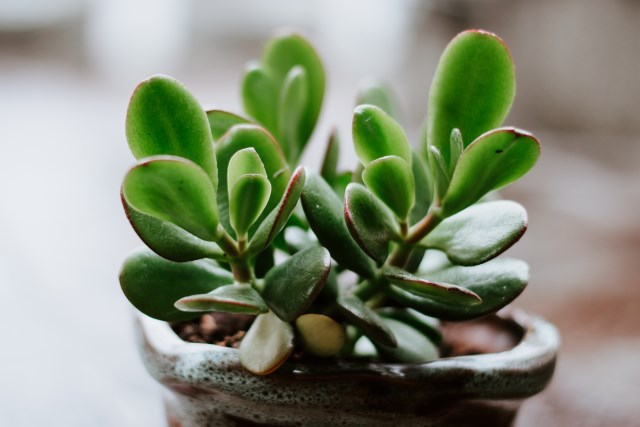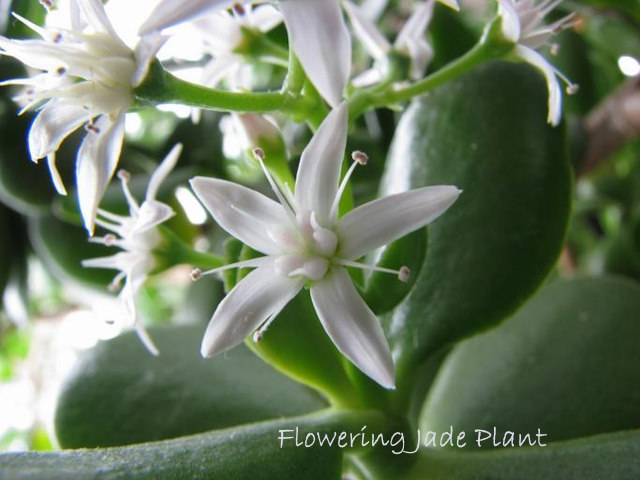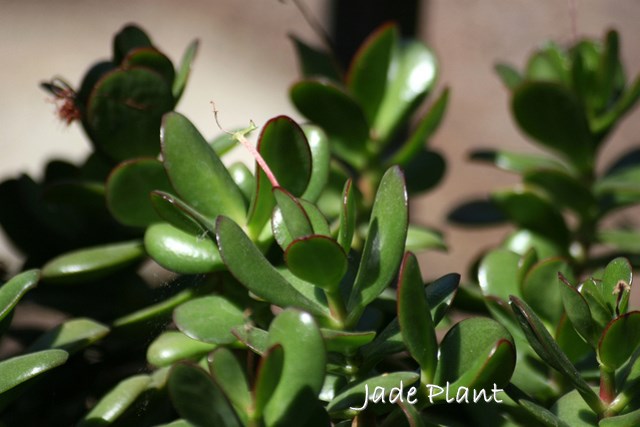Jade Plant Care
Jade plant care is easy, making it an ideal houseplant for beginners... or anyone who wants an eye-catching, long-lived indoor plant.
Native to South Africa, this many-branched, succulent shrub tolerates the dry environment of heated homes well. Here, you'll discover how much water and sunlight it wants, when to repot, how to get it to bloom, and more. Treat it right and you'll enjoy your indoor plant for many years.
Jade gets more beautiful with age. Put your jade houseplant in a decorative container to show it off. Jade's upright tree-like form makes it a stunning accent for a sunny room.
 Jade plant is easy to grow indoors, preferring warmth and sunshine year-round.
Jade plant is easy to grow indoors, preferring warmth and sunshine year-round.Get to Know Jade Plant
Known botanically as Crassula ovata, this succulent shrub is native to South Africa.
Its tree-like woody branches are covered with shiny, plump, spoon-shaped green leaves that are sometimes tinged in crimson. Jade branches naturally, so it doesn't need pruning.
How big does jade plant get? Grown indoors, it may eventually grow to 3 ft (90 cm) tall. When grown as a bonsai, jade plant only reaches 1 ft (30 cm) or less.
How long will jade plant live? You can expect 10 years or more from your houseplant. You can keep it going by propagating your plant from tip cuttings.
Will it bloom? Maybe. Indoor plants that are several years old may produce clusters of small, white, star-shaped flowers, if given enough sun. Cooler temps (around 55-60°F/13-16°C) and less water during the winter months will encourage blooms in spring.

Caring for Jade Plant Indoors
Jade plant doesn't need much attention at all. Just put it in a bright location. Wait till the top of the soil is dry before watering because this succulent plant stores water in its fleshy leaves, woody stems and thick roots.
Slow-growing, jade only needs repotted when it outgrows its container, probably every 2-3 years. Put your plant in a heavy container to help balance its weight -- it can get top-heavy. Also, be sure to use a container with a drainage hole to keep the soil from getting soggy.
Jade plant problems are few. Watch for mealybugs -- the white, fuzzy bugs that attach themselves to the leaves and stems. A wilted plant could be a sign of an infestation. However, overwatering could also cause wilting.
Brown, shriveled spots on leaves or dropping leaves are signs that the soil is too dry. Keep this succulent plant on the dry side, but don't allow it to dry out completely.
 What sets this Crassulaceae apart from many other types of succulents is its branched, tree-like form.
What sets this Crassulaceae apart from many other types of succulents is its branched, tree-like form.Jade Plant Care Tips

Light: Bright light with some direct sun. Give your jade plant a quarter turn every week or so to expose all side to sunlight for even growth. Spindly plants with few leaves need more sunlight.
Water: Jade plant stores is a succulent that stores water in its leaves, stems and thick roots, allowing it to go for days without a drink. Allow soil to dry out slightly between waterings, but don't allow the soil to get completely dry. Dropped leaves or brown spots on leaves are signs that the plant needs more water.
Humidity: Average room humidity (about 40-50% relative humidity). Jade will tolerate dry air.
Temperature: Average room (65-75°F/18-24°C) all year long. If you move your plant outdoors for the summer, don't worry -- it can take the heat. Bring it back indoors when the nighttime temperature drops -- jade plant will tolerate a minimum of 50°F/10°C.
Soil: Give this succulent plant a fast-draining mix to prevent root rot, such as 2 parts peat moss-based potting mix and 1 part horticultural sand or perlite.
Fertilizer: Feed monthly from spring through fall with a liquid fertilizer specially made for succulents, diluted by half. Do not feed in winter when growth is slower.
Propagation: Take leaf cuttings or 3-inch (7.5 cm) stem cuttings in spring. Allow cuttings to dry out for about 5 days (to prevent them from oozing sap) before potting them in moist potting mix.


